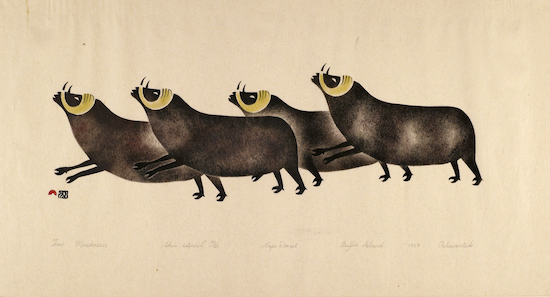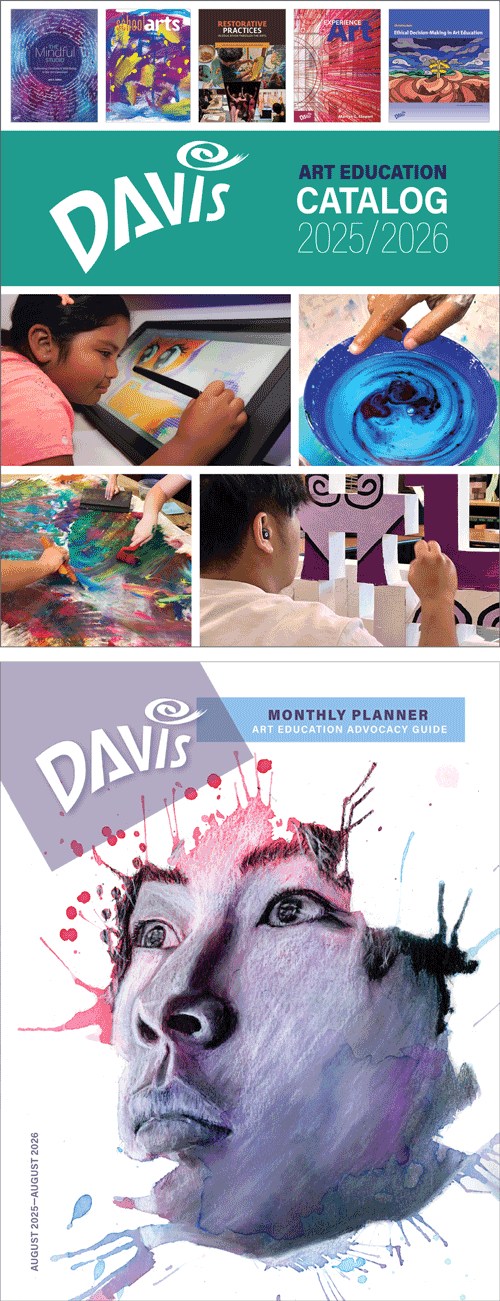Artist Birthday: Osuitok Ipeelee
The native arts of the northern First Nations cultures of Canada have the same wide ranging types of art forms as those of the Indigenous cultures of the US. Osuitok Ipeelee participated in a Canadian government effort to broaden the recognition of First Nations artists during the mid-1900s.
Artist Birthday for 13 November: Osuitok Ipeelee (1923-2005, Inuit Culture, Cape Dorset, Nunavut, Canada)
 |
| Osuitok Ipeelee, Four Musk Oxen, 1959, sealskin stencil, 30.3 x 55.8 cm Brooklyn Museum, © 2025 Artist or Estate of Artist (BMA-2218) |
Osuitok pursued a brief interest in printmaking after conversations with James Houston (1921-2005), a Canadian artist who had helped establish the West Baffin Island Artist Cooperative (1958). Houston had suggested the establishment of a printmaking cooperative (the Cape Dorset Graphics) to disseminate Aboriginal art to a larger public, and improve Inuit economic opportunity.
Ironically, Osuitok produced only four prints for the coop in 1958 and 1959, citing lack of sufficient remuneration for his efforts. Still, his beautifully executed stencil print has all of the elegance, monumentality and vitality of his sculptures. Inuit prints tend to feature subjects that reflect Inuit everyday life. Musk oxen have traditionally been a source of meat for food, fur for clothing and insulation, and bone and horn for tools. The isolation of the images on a blank background creates a stark contrast between positive and negative shapes, as well as establishing an almost iconic image of the important animal.
Background
The ancestors of the Arctic and Sub-Arctic peoples arrived in North America at different times. The Sub-Arctic was the last region populated before the ice covered over communication across the Bering Straits 12,000 years ago. The ancestors of many of the peoples previously known as "Eskimo" arrived about 4000 years ago, after the receding glaciers again permitted people to cross from Siberia into what is now Alaska and Canada.
Until the time of United States and Canadian settlement of the Arctic region, many of the Native people, particularly those in the interior regions, lived in small nomadic communities. These communities traveled seasonally to follow the migration of animals. Inuit inhabit vast areas of Nunavut, the Northwest Territories, the coast of northern Labrador and approximately 25 percent of northern Quebec. Traditionally, they have lived above the tree line in the area bordered by Alaska to the west, the Labrador coast to the east, the southern tip of Hudson Bay to the south and the High Arctic Islands to the north.
All the Arctic peoples speak languages belonging to the same cultural group. Within this group there are distinct branches. The Inuit speak the same languages as the Inupiaq who live along the Northern Bering Strait and Beaufort Sea. In Alaska the term Eskimo is used by Arctic peoples while in Canada and Greenland "Inuit" (meaning "the people") is preferred.
In Canada, there was no equivalent to the Studio School in Santa Fe where native artists were encouraged to get an arts education. After almost half of the 1900s spent in re-culturalization and forced Western schooling, many young native artists had lost all connection to their native languages, as well as traditions, and traditional art forms. Many of the artists maturing in the mid- late 1900s perceived the goal of their art to record and preserve their vanishing way of life and traditions.
Qsuitok Ipeelee, once known as Qshaweetok B, was predominantly known as a sculptor. He was born at Neeouleeutalik Camp, Nunavut. His forefathers, native to West Baffin Island, were not part of the migration from Arctic Québec. His family was also renowned as sculptors. Osuitok was famous for his delicate, and elegant carving of indigenous animals of Nunavut, particularly caribou.
Correlations to Davis programs: Explorations in Art 1E, 5th Grade, Unit 4.21; Explorations in Art 2E, Grade 2, Unit 3.1; A Community Connection 2E, Unit 8.2; Davis Collections -- First Nations Art, US and Canada; Davis Collections -- Canadian Artists

Comments